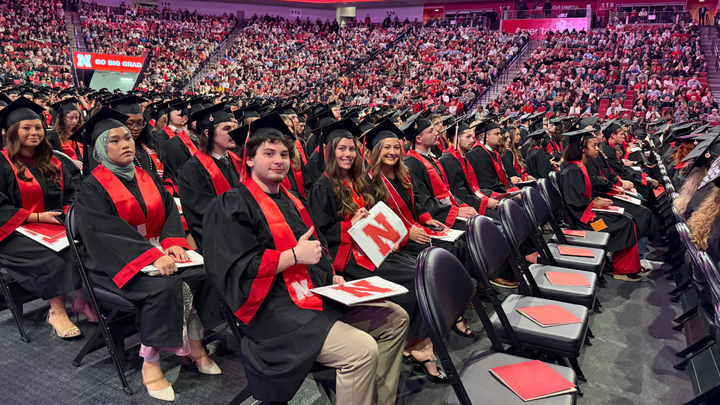In recent years, university discussions about budgets and budget cuts have been prevalent. But what exactly does this entail, and how has the college approached budgetary challenges?
The college's financial operations are supported by four main revenue streams: the state-aided budget, revolving/auxiliary funds, sponsored program funds, and foundation funds. The most significant portion of our funding comes from the state-aided budget, which is usually the focus of university conversations about the budget, particularly when addressing budget reductions.
This emphasis on the state-aided budget in discussions is due to its critical role in the institution's overall financial health, impacting everything from academic programs to infrastructure and services. Budget cuts affect this primary source of funding, leading to adjustments and reevaluations of spending priorities across the university.
Our Budget
As of today, the college's state-aided budget stands at $5,694,014. A substantial 93% of these funds are allocated towards salaries and benefits for our administrators, faculty, staff, and student workers, underscoring our commitment to attracting and retaining top-tier talent to support our educational mission. The remaining 7% is utilized for essential operational costs, including employee recruitment efforts and the maintenance of basic office infrastructure—such as phones, data ports, and copiers—alongside investments in computer and studio equipment. This portion of the budget also covers services provided by the business center and Information Technology Services (ITS), ensuring our college remains a vibrant and efficient learning environment.
|
Category |
FY 24 |
% of Total |
|
Academic Administrator |
$ 396,168 |
7.0% |
|
Faculty |
$ 2,958,213 |
52.0% |
|
Staff |
$ 687,750 |
12.1% |
|
Graduate Assistants |
$ 79,154 |
1.4% |
|
Student Workers |
$ 30,814 |
0.5% |
|
Benefits |
$ 1,150,022 |
20.2% |
|
Operating |
$ 391,893 |
6.9% |
|
Total |
$ 5,694,014 |
|
Various budgeting methods are used across the country, including incremental budgeting, responsibility-centered management, incentive-based budgeting, and zero-based budgeting. The University of Nebraska-Lincoln uses incremental budgeting.
In this method, the budget for the upcoming period is created by making minor adjustments to the current budget. At the university, the small adjustments are typically increases from the annual salary increase program and decreases due to budget cuts. This method assumes that the existing budget's baseline is essentially correct and that only minor modifications are needed. This budgeting method is easy to implement and doesn't require complex calculations; it is stable and predictable and an efficient way to allocate resources. However, it also has the potential for complacency, where inefficiencies and unnecessary expenditures can be perpetuated year after year. It lacks responsiveness to change in student enrollment, research productivity or service capacity within the units and can inhibit growth and innovation by failing to allocate sufficient resources to new initiatives with high growth potential.
Using incremental budgeting over the past five years has resulted in a slight reduction in the college's total state-aided budget. In fiscal year (FY) 2020, the budget stood at $5,716,395, whereas today, it is $5,694,014. This represents a total decrease of $22,380.
Let’s examine how that happened.
Fiscal Year 2020
|
FY 20 |
|
|
Starting Budget |
$ 5,409,078 |
|
Salary Increases |
$ 376,342 |
|
Budget Reduction |
$ (69,025) |
|
Faculty Reversion |
$ - |
|
Ending Budget |
$ 5,716,395 |
At the start of fiscal year 2020, the college's budget was $5,409,078. We received increases totaling $376,342, including the hire of Dean Veil. The Office of the Executive Vice Chancellor provides dean salaries to the colleges. However, when deans leave the university, the entirety of their salaries return to the EVCs' office.
In FY 20, the college faced budget reductions totaling $69,025. Unlike traditional budget cuts, this decrease did not stem from a standard budget reduction process. Instead, it originated from a unique initiative by EVC Plowman, which consolidated all temporary instructor budget lines from the colleges into the EVC's office. Subsequently, these funds were reallocated to support hiring full-time faculty across academic units. The reduction signifies the college's net loss through this program, effectively dissolving our budget for temporary instructors.
Despite the elimination of specific budget lines for temporary instructors, the college continues to bear the responsibility of funding temporary instructional roles. To manage this essential operational cost, we've turned to our cash reserves—a pool of unspent funds accumulated over time—and the budget lines of vacant full-time faculty positions.
The changes resulted in a $307,317, or 5.7%, increase in the college's budget.
Fiscal Year 2021
|
FY 21 |
|
|
Starting Budget |
$ 5,716,395 |
|
Salary Increases |
$ 59,084 |
|
Budget Reduction |
$ (137,122) |
|
Faculty Reversion |
$ (34,925) |
|
Ending Budget |
$ 5,603,432 |
In fiscal year 2021, amidst the financial challenges posed by the COVID-19 pandemic, the college navigated a complex budgetary landscape. We were allocated $59,084 for annual salary increases for our existing employees.
During the same period, the university embarked on a three-year formal budget reduction initiative to address a budget deficit exacerbated by the pandemic's impact. In the first year of this program, the college was required to contribute $137,122 towards these budget cuts.
Further adjustments were made as part of the faculty salary revision policy, which mandates that 15% of the budget lines for all full-time faculty positions are redirected to the Executive Vice Chancellor's office upon the departure or retirement of faculty members. This reallocation supports funding dual hires and other strategic priorities across the campus. Consequently, the college experienced an additional budget reduction of $34,925 due to faculty reversion, leaving 85% of each faculty budget line within the college to facilitate new faculty appointments.
The cumulative effect of these changes resulted in a net reduction of $112,963 to the college's budget for FY 21, equivalent to a 2% decrease from the previous fiscal year.
Fiscal Year 2022
|
FY 22 |
|
|
Starting Budget |
$ 5,603,432 |
|
Salary Increases |
$ 159,577 |
|
Budget Reduction |
$ (42,458) |
|
Faculty Reversion |
$ (213,378) |
|
Ending Budget |
$ 5,507,173 |
In Fiscal Year 2022, the university implemented a faculty salary compensation program to enhance the competitiveness of tenure-line faculty salaries. Coupled with the annual salary increase program for all employees, this initiative resulted in a notable budget increase of $159,577 for the college.
However, the college also faced financial challenges during this period. Specifically, it underwent a budget reduction of $42,458 as part of the second year of a budget cut program initiated in response to the fiscal constraints imposed by the COVID-19 pandemic. Moreover, the college encountered a significant loss of $213,378 due to the faculty salary reversion program. This program's impact was particularly felt with the departure of former dean Gary Kebbel, as his complete budget line was reclaimed by the EVC's office, given his prior role within the college.
These developments collectively led to a net decrease in the college's budget of $96,259, corresponding to a 1.7% reduction.
Fiscal Year 2023
|
FY 23 |
|
|
Starting Budget |
$ 5,507,173 |
|
Salary Increases |
$ 289,781 |
|
Dean's Hiring Package |
$ 147,000 |
|
Budget Reduction |
$ (157,086) |
|
Faculty Reversion |
$ (51,155) |
|
Ending Budget |
$ 5,735,713 |
In Fiscal Year 2023, the university continued with the faculty salary compensation program, with an additional allocation of funds to the colleges to address tenure-line faculty salaries. This allocation, in addition to the annual salary increase program, resulted in a budget increase of $289,781.
During this period, the college embarked on strategic efforts to elevate the competitiveness of both the non-tenure line and staff salaries. Leveraging the faculty compensation program's proceeds, the college awarded market adjustments and merit increases to tenure-line faculty. The college utilized the entirety of the faculty portion of the annual salary increase program for market adjustments and merit increases for non-tenure line faculty. (It is important to note that CoJMC is one of only two colleges on campus that use the same salary rates for tenure-line and non-tenure-line faculty within each discipline.) Staff salaries were also enhanced through market and merit adjustments, utilizing the staff portion of the annual salary increase program, supplemented by reallocated funds from the college's operational budget and other activities.
When Dean Veil assumed her role in 2020, she successfully negotiated for additional full-time faculty positions based on the anticipation that the university would adopt a responsibility-centered management (RCM) budget model. This model promised the college greater financial autonomy by allowing it to retain the revenue it generated from sources such as student credit hours and grant proceeds, which would then be reinvested into its operations. This approach marked a significant departure from the traditional incremental budget model that allocated funds to the college on a fixed basis without directly linking financial resources to the college's revenue-generating activities. Based upon the initial models of the college's budget under RCM, the college expected to receive a sizable budget increase with the implementation.
The initial agreement included the provision by the Executive Vice Chancellor's office to front the initial costs for these new positions, with the understanding that the college would absorb these expenses once the benefits of the RCM model began to materialize. However, the unexpected arrival of the COVID-19 pandemic and subsequent changes in university leadership prompted a reevaluation of this plan, ultimately leading to the decision to retain the incremental budget model.
Despite this shift, to uphold the commitments made to Dean Veil, the EVC's office provided budget increases to the college in FY 23 ($144,000) and FY 24
However, the college also navigated financial challenges in FY 23, facing $157,086 in reductions due to the third year of pandemic-related budget cuts, alongside a $51,155 deduction under the faculty salary reversion program.
Despite these challenges, the cumulative effect of these initiatives and adjustments resulted in a net budget increase of $228,540 for the college, equivalent to a 4.1% enhancement.
Fiscal Year 2024 (this year)
|
Starting Budget |
$ 5,735,713 |
|
Salary Increases |
$ 130,615 |
|
Dean's Hiring Package |
$ 72,000 |
|
Budget Reduction |
$ (244,314) |
|
Faculty Reversion |
$ - |
|
Ending Budget |
$ 5,694,014 |
In Fiscal Year 2024, the college benefited from a $130,615 infusion under the annual salary increase program, earmarked for merit-based increases to faculty and staff salaries. Further bolstering our resources, the college received $72,000 as part of a commitment to Dean Veil to add new full-time faculty positions.
Despite these positive developments, the university faces ongoing financial challenges, marked by significant budget deficits. These deficits stem from a combination of decreasing student enrollment over the past five years and escalating operational costs exacerbated by rising inflation. In response to these financial pressures, the university launched a comprehensive budget reduction initiative, leading to budget cuts totaling $244,314 for the college.
After accounting for these dynamics, the college's budget ultimately decreased by $41,699, or 1%.
Impacts of the changes and looking ahead
Over the last five years, a transformative outcome of our budgetary strategy has been the substantial improvement in the competitiveness of our employee salaries. Initiatives like the faculty compensation program and strategic fiscal decisions in Fiscal Year 2023 have led to significant salary increases for a broad segment of our workforce. Since 2020, the compensation landscape has seen remarkable growth: faculty salaries have increased by 5.5%, while staff salaries have experienced a robust rise of 36.3%. These advancements highlight our college's deep commitment to valuing the dedication and effort of our staff and faculty, ensuring our ability to attract and retain elite professionals.
Despite these positive developments, the college faces imminent challenges due to budget reductions over the same period. A critical issue emerging from these financial constraints is our capacity to fund temporary instructional positions. The discontinuation of budget allocations for temporary instructors in FY 20, alongside cumulative reductions amounting to $177,968 in our full-time faculty budget since FY 20, has led to a scenario where available funds are exclusively committed to full-time faculty. This situation is compounded by our proactive hiring in recent years, leaving no financial room for temporary faculty appointments.
Looking ahead to Academic Year 24-25, the college anticipates the need to engage temporary instructors for 95 course sections to fulfill student demand at an estimated cost of $348,917. Without designated funds within our state-aided budget, we are tasked with exploring innovative strategies to meet this essential operational requirement without over-relying on temporary faculty.
Additionally, the college has encountered a 54.6% cut in our budget for student workers at a time when the expenses associated with supporting essential services like recruitment, office management, student retention, and other operations are on the rise. In Fiscal Year 25, we project a budget of $30,814 for student workers against anticipated expenses surpassing $120,000. Efforts led by Dean Veil are underway to bridge this financial gap through various funding initiatives.
Moreover, the college has seen a significant reduction of $193,274 in its operational budget, prompting a reduction in our operational expenditures, including minimizing the number of phones and active data ports. Yet, with inflation driving costs upward, vigilant management of operational expenses and pursuing alternative funding sources will be crucial to sustaining our fundamental operational needs.
As we move forward and consider our budgetary needs, there are a couple of other considerations to keep in mind.
Graduate Assistants
Over the past five years, the college's graduate assistant budget has remained flat and currently totals $79,154. This fixed budget allows the college to offer each graduate assistant a stipend of $15,000 in the first year and $15,500 in the second year. Given these stipend rates, the college can fund five graduate assistants using state-aided funds.
Additionally, the college funds one graduate assistant through the interest generated from foundation endowments and has historically supplemented the support of additional graduate assistants using cash reserves from foundation accounts. However, these reserves are depleting and are projected to sustain only one more graduate assistant for two years.
Consequently, the college anticipates being able to support a total of seven graduate assistants for the next two years (FY 25 and FY 26), with this number decreasing to six starting from FY 27. This projection does not account for graduate assistants financed through grants.
Earlier in the year, the Office of Graduate Studies successfully advocated for an increase in the minimum compensation for graduate assistants, raising the stipend from $14,000 to $15,000 annually. This adjustment aligns our starting stipends with the new minimum, prompting a potential reevaluation of our stipend offerings to ensure the competitiveness of our graduate assistant positions.
Given the anticipated reduction in the number of graduate assistants, it may become necessary to reassess how we allocate this vital resource within the college, ensuring that it continues to effectively support our educational and research missions.
Employee salaries
Despite the positive steps taken in FY 23, the university lacks a robust funding strategy to ensure the competitiveness of employee salaries in the long run. The university's annual salary increase program has not been able to match the inflation rate in recent years and is expected to continue this trend. To sustain competitive compensation levels, the college may need to consider reallocating funds to adjust the salaries of current employees in line with market rates, especially upon employee turnover. In the absence of new sources of revenue, such a strategy could lead to a decrease in the total number of positions that the college's budget can sustain. This scenario might necessitate scaling back operations or enhancing operational efficiencies to uphold our fundamental mission without compromising the quality of education and service we provide.
Over the past five years, the college has navigated through a series of budgetary adjustments under the incremental budgeting method, resulting in a nuanced financial landscape. This period has witnessed efforts to enhance faculty and staff competitiveness through salary adjustments, with notable increases in average salaries. However, these fiscal years have also been marked by challenges such as reductions in temporary instructor funding, operational budget cuts, and the diminishing capacity to support student workers and graduate assistants due to flat budgets and dwindling foundation reserves.
The college's strategic response to these financial challenges has been multifaceted, focusing on maintaining operational efficiency and educational quality despite budget constraints. Initiatives such as reallocating funds for competitive salary adjustments and exploring new funding strategies for graduate assistantships highlight the college's commitment to its core mission. Nevertheless, the ongoing financial pressures, including the effects of inflation and declining enrollment, underscore the need for continued innovation in budget management. As the college looks to the future, the emphasis will be on finding sustainable solutions to these challenges, ensuring the continued support of its educational and research missions in an ever-evolving fiscal environment.



